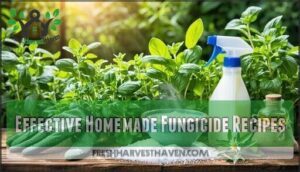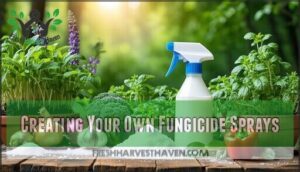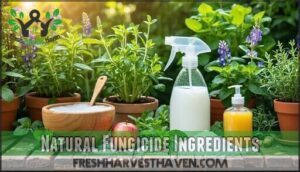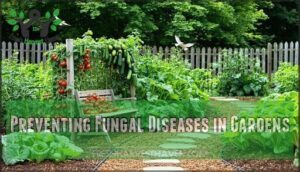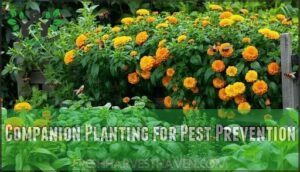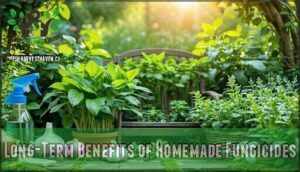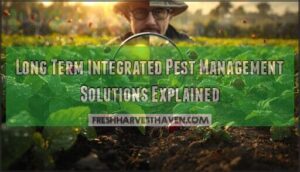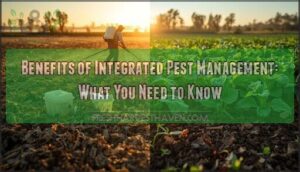This site is supported by our readers. We may earn a commission, at no cost to you, if you purchase through links.
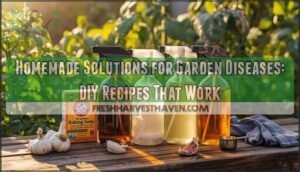
Baking soda disrupts fungal spore development, garlic provides antimicrobial sulfur compounds, and apple cider vinegar creates hostile conditions for pathogens. Mix these ingredients with water and horticultural soap for improved effectiveness against powdery mildew, black spot, and other fungal infections.
The key lies in understanding which combinations work best for specific diseases and proper application timing.
Table Of Contents
- Key Takeaways
- Fighting Garden Diseases Naturally
- Effective Homemade Fungicide Recipes
- Creating Your Own Fungicide Sprays
- Applying Homemade Fungicides Safely
- Natural Fungicide Ingredients
- Preventing Fungal Diseases in Gardens
- Attracting Beneficial Insects for Pest Control
- Maintaining a Healthy Garden Environment
- Companion Planting for Pest Prevention
- Long-Term Benefits of Homemade Fungicides
- Frequently Asked Questions (FAQs)
- How do you treat garden maladies?
- How do you get rid of a sick plant?
- Can you use natural fungicides in your garden?
- How can you avoid harsh chemicals in the garden?
- How do you get rid of fungicide on plants?
- Can you use homemade fungicide spray on plants?
- How to cure plant disease naturally?
- How do you make natural pest control for gardening?
- How to treat abiotic disease in plants with home remedies?
- How to remove disease from soil?
- Conclusion
Key Takeaways
- You’ll save significant money making fungicides from kitchen ingredients like baking soda, garlic, and vinegar that cost under $1 compared to $20 commercial alternatives while delivering equal effectiveness.
- You can create targeted treatments for specific diseases by understanding which ingredients work best—baking soda disrupts fungal spores, garlic provides antimicrobial compounds, and vinegar creates hostile conditions for pathogens.
- You’ll protect your garden’s ecosystem by using natural solutions that nurture beneficial soil organisms instead of destroying them like synthetic chemicals do, building long-term garden health.
- You must apply homemade fungicides during cooler morning hours and test on small plant areas first to prevent leaf burn, while timing weekly applications for prevention rather than waiting for visible infections.
Fighting Garden Diseases Naturally
Garden diseases can wreck your plants faster than you’d expect, turning healthy foliage into spotted, wilted messes. You can fight back with simple homemade fungicides made from ingredients already in your kitchen cabinet.
Common Garden Diseases
Most gardeners encounter the same troublesome plant diseases that can turn a thriving garden into a frustrating battleground. Understanding common garden diseases helps you spot problems before they spread throughout your entire crop.
Fungal diseases are your garden’s most persistent enemies. These microscopic invaders thrive in humid conditions and poor air circulation, creating perfect breeding grounds for destruction. Disease diagnosis becomes easier when you recognize these telltale signs:
- White powdery coating on leaves indicating powdery mildew infection
- Dark circular spots spreading across foliage from soil pathogens
- Yellowing leaves that drop prematurely despite adequate watering
- Stunted plant growth with wilted appearance during cool mornings
Fungal infections often start with environmental stress factors like overcrowding, excessive moisture, and poor garden hygiene practices. Plant pests can also create entry points for diseases through feeding wounds. Regular scouting helps catch garden diseases early, giving you better treatment options. Proper spacing, adequate drainage, and removing infected plant debris form your first line of disease prevention defense against these persistent invaders. Effective disease control strategies are essential for maintaining a healthy garden ecosystem.
Benefits of Homemade Solutions
Understanding common garden diseases is just the first step. Now let’s explore why homemade solutions for garden diseases outperform commercial chemicals in every way that matters to your garden’s success.
Cost Savings lead the charge – you’ll spend under a dollar creating treatments that work better than $20 store-bought alternatives. Your kitchen cabinet already contains powerful natural remedies like baking soda and vinegar that deliver professional results.
| Benefit | Homemade Solutions | Commercial Fungicides |
|---|---|---|
| Cost per application | $0.25-$0.50 | $3.00-$8.00 |
| Environmental impact | Zero toxins | Chemical runoff |
| Soil health | Feeds microorganisms | Kills beneficial bacteria |
| Safety for pets/kids | Completely safe | Requires precautions |
| Effectiveness | Targeted disease prevention | One-size-fits-all |
These Eco Friendly treatments support Sustainable Gardening by nurturing beneficial microorganisms instead of destroying them. Your natural fungicide recipes create a Healthy Ecosystem where plants thrive naturally. You’re not just treating problems – you’re building long-term garden resilience while protecting your family and environment from harmful chemicals.
Effective Homemade Fungicide Recipes
You’ll find that nature provides some of the most effective fungicides right in your kitchen and garden. These simple, homemade recipes can tackle common plant diseases while keeping your garden safe from harsh chemicals.
Baking Soda Fungicide
Baking soda fungicide transforms your kitchen staple into a powerful weapon against plant diseases. This natural fungicide works by creating an alkaline environment that disrupts fungal spore development and prevents new infections from taking hold.
Research shows baking soda reduces powdery mildew severity by over 50% when applied weekly. The simple recipe combines one tablespoon of baking soda with one gallon of water, plus one teaspoon of liquid soap for better leaf adhesion.
- pH disruption: Alters leaf surface conditions, making them hostile to fungal growth
- Proven effectiveness: Field trials show similar results to commercial fungicides for black spot
- Safe application: No toxic residues remain on harvested fruits or vegetables
Apply your baking soda spray during cooler morning hours to prevent leaf burn. Weekly preventative treatments work better than waiting for visible infections. Don’t exceed 1% concentration, as stronger solutions can damage plant tissue. Reapply after rain since water washes away protective residues, leaving plants vulnerable again. For more information on using baking soda as a natural fungicide solution, consider the various products available.
Garlic and Hot Pepper Fungicide
Hot Pepper Extract packs a powerful one-two punch when combined with Garlic Spray. This homemade fungicide leverages garlic’s sulfur compounds and capsaicin’s antimicrobial properties for enhanced Fungal Resistance.
Mix ten crushed garlic cloves with two hot peppers in a quart of water, then strain after 24 hours. This Natural Preservatives blend acts as one of the most effective Organic Pesticides you can make.
Your garlic pepper spray creates an inhospitable environment for fungal pathogens while deterring pests naturally. Apply this natural fungicide weekly during disease-prone seasons for maximum protection.
Apple Cider Vinegar Fungicide
Apple cider vinegar fungicide utilizes acetic acid benefits to combat stubborn plant diseases naturally. This potent vinegar spray creates hostile conditions that fungal pathogens simply can’t survive in, making it one of the most reliable natural remedies for organic gardening enthusiasts.
Your apple cider vinegar spray works by lowering the pH around infected plant tissues, disrupting fungal cell walls and preventing spore germination. Here’s your battle plan:
- Mix the Solution: Combine 3 tablespoons of apple cider vinegar per gallon of water
- Test First: Apply to small leaf areas to check plant tolerance before widespread use
- Apply Strategically: Spray every 7-10 days during active infections, monthly for prevention
- Time It Right: Use during cooler morning hours to prevent leaf burn
This homemade fungicide recipe delivers consistent results while keeping your garden chemical-free and your wallet happy.
Horseradish Fungicide
While apple cider vinegar addresses many fungal problems, horseradish fungicide delivers serious firepower against the toughest garden diseases. This pungent root contains potent antimicrobial compounds that demolish brown rot, powdery mildew, and black spot.
Create your horseradish fungicide by soaking one cup of fresh horseradish roots in 16 ounces of water overnight. Strain the mixture, then dilute with two quarts of water before spraying.
Horseradish Benefits Application Frequency Plant Compatibility
homemade garden disease remedies
This natural fungicide provides excellent garden protection through organic solutions that won’t harm your soil’s ecosystem.
Creating Your Own Fungicide Sprays
You can create powerful fungicide sprays using simple household ingredients that target specific plant diseases effectively. These DIY recipes offer targeted solutions for different fungal problems while remaining safe for your garden’s ecosystem.
Cornmeal Fungicide Spray
While cornmeal fungicide spray sounds promising, research shows mixed results for disease prevention. Texas A&M studies found no reliable suppression of fungal diseases, though cornmeal benefits may include improved soil health.
To make this natural fungicide:
- Soak 1 cup horticultural-grade cornmeal in 1 gallon water overnight
- Strain mixture thoroughly through fine mesh
- Transfer to spray bottle immediately
- Apply to affected plants during cool morning hours
This homemade fungicide costs pennies but lacks consistent scientific backing for spray applications against garden pathogens.
For effective soil disease control, consider using products with proven track records, such as Horticultural Grade fungicides.
Aspirin Fungicide Spray
You’ll be amazed at how well aspirin benefits your garden when battling fungal diseases. This homemade fungicide utilizes salicylic acid to activate your plants’ immune systems, making them stronger disease fighters.
Create your aspirin fungicide spray by crushing one 325mg aspirin tablet and dissolving it completely in four cups of water. Add a teaspoon of mild soap to help the mixture stick to leaves better. This simple garden remedies approach works particularly well on tomatoes, roses, and peppers.
Spray applications should happen every two weeks during cool morning hours when temperatures won’t stress your plants. The disease prevention magic happens as salicylic acid triggers natural defenses before problems start.
These fungicide recipes offer excellent preventative sprays protection, but don’t overdo it—too much aspirin can harm rather than help. Rotate with other fungicide treatments like neem oil between applications for best results. Your plants will thank you for this gentle, effective protection. Understanding aspirin fungicide properties is key to successful garden disease management.
Painted Daisies Fungicide Spray
Since painted daisies contain natural pyrethrins, they create powerful homemade fungicides with impressive efficacy against various garden diseases. These daisy extracts work differently than other garden remedies, targeting both fungal problems and natural pest issues simultaneously.
Here’s your spray application method:
- Flower Preparation: Dry painted daisy flowers completely, then grind into a fine powder for maximum potency.
- Extraction Process: Steep ground flowers in water for 24 hours, strain thoroughly before use.
- Safety Protocol: Handle carefully, as pyrethrins are potent compounds that require proper precautions.
Your painted daisies fungicide spray provides dual-action protection through targeted fungicide sprays that combat diseases while deterring pests naturally.
Applying Homemade Fungicides Safely
You’ll want to test homemade fungicides on a small plant section before treating your entire garden to avoid potential leaf damage. Apply these natural treatments during cooler morning or evening hours when temperatures won’t stress your plants or cause the solutions to burn delicate foliage.
Testing Fungicide on Small Areas
Smart gardeners know that testing your homemade fungicide on small areas prevents plant damage. Select a single leaf and apply your fungicide treatment, then wait 48 hours to assess plant sensitivity. This small scale testing reveals potential fungal resistance patterns while protecting your garden investment.
| Test Parameter | Day 1 | Day 2 | Day 3 |
|---|---|---|---|
| Leaf color changes | Monitor yellowing | Check browning | Note recovery |
| Fungicide efficacy signs | Initial reaction | Full response | Long-term effects |
| Spray application damage | Burn spots visible | Tissue damage | Overall health |
| Control comparison | Baseline normal | Difference noted | Final assessment |
Timing Fungicide Applications
Anyone can master timing fungicide applications with the right fungicide schedules. Apply homemade fungicide during early morning hours when temperatures stay cool and humidity levels drop. This treatment timing prevents leaf burn while maximizing absorption.
Use disease forecasting to anticipate problems—check plants weekly for early symptoms of fungal diseases. Space spray intervals seven to fourteen days apart, adjusting application frequency based on weather conditions. Rain washes away treatments, so reapply afterward.
Preventing fungal diseases requires consistency, not strength. When applying homemade fungicides, timing beats concentration every time for effective protection.
Avoiding Overuse of Fungicides
Most gardeners eventually learn that even natural solutions can cause problems when overused. Your homemade fungicide works best with strategic restraint rather than frequent applications.
Excessive use of any fungicide, even organic alternatives, can disrupt beneficial microorganisms and create fungicide resistance in your garden. Here’s how to maintain balance:
- Rotate different recipes like baking soda fungicide and vinegar sprays to prevent adaptation
- Apply treatments only when you spot early signs of fungal diseases
- Combine eco friendly methods with integrated pest management for sustainable gardening success
Natural Fungicide Ingredients
Natural fungicide ingredients work by targeting the specific conditions that allow fungal diseases to thrive in your garden. Common household items like baking soda, milk, apple cider vinegar, and even mouthwash contain compounds that create hostile environments for harmful fungi while remaining safe for your plants.
Baking Soda and Horticultural Soap
You’ll find baking soda and horticultural soap create an unbeatable team against fungal diseases in your garden. This powerful combination works by raising the pH level around plant surfaces, making conditions hostile for fungi while the soap helps your homemade fungicide stick to leaves effectively.
Creating effective soap solutions starts with mixing one tablespoon of baking soda per gallon of water, then adding a few drops of mild soap. This simple recipe transforms ordinary baking soda uses into professional-grade fungicide treatments that rival commercial products.
Your timing matters when applying these natural remedies:
- Apply during cool morning hours to prevent leaf burn
- Reapply weekly or after rain for consistent protection
- Test on small leaf sections before full application
- Store unused mixture for up to one week
These horticultural tips guarantee your baking soda fungicide remains potent while protecting beneficial insects and soil health. For ideal results, understanding baking soda fungicide properties is essential to create effective garden disease treatments.
Milk and Antifungal Properties
Regular milk treatment utilizes lactic acid and proteins as powerful antifungal agents against fungal diseases. You’ll find dairy remedies using any milk type—whole, skim, or powdered—mixed with water create effective natural remedies for disease prevention.
This homemade fungicide develops fungal resistance through milk’s disease-fighting properties, requiring weekly applications for maximum protection. Using a natural fungicide approach can help gardeners prevent common fungal infections in their vegetable gardens.
Ethanol-Based Mouthwash
Beyond your bathroom cabinet lies an unexpected fungicide ally. Ethanol-based mouthwash creates potent antimicrobial action that disrupts fungal cell walls while remaining gentle on plants when properly diluted.
Three Application Methods for Maximum Control:
- Standard spray: Mix one part sugar-free mouthwash with three parts water for routine disease prevention.
- Enhanced formula: Add liquid soap to improve leaf coverage and natural sanitizer effectiveness.
- Gentle treatment: Use 1:4 dilution ratio for tender plants requiring antiseptic sprays.
Apple Cider Vinegar and Acetic Acid
Apple cider vinegar transforms ordinary garden care into a powerful weapon against fungal diseases. You’ll utilize the acidic properties of acetic acid to create an effective vinegar spray that disrupts fungal inhibition naturally. This organic remedy uses natural acids to break down spore walls and create a hostile environment for pathogens.
| Application Method | Concentration | Target Disease |
|---|---|---|
| Foliar spray | 1 tbsp per gallon | Powdery mildew |
| Soil drench | 2 tbsp per gallon | Root rot |
| Preventive mist | 1/2 tbsp per gallon | Black spot |
| Weekly treatment | 1 tbsp per gallon | Blight |
| Post-rain application | 1 tbsp per gallon | General fungal issues |
Your apple cider vinegar fungicide delivers consistent results without harsh chemicals. Mix this homemade fungicide carefully—too strong burns leaves, too weak won’t work. Apply during cooler morning hours for best results. This natural remedy costs pennies compared to commercial alternatives while protecting beneficial soil microbes.
Preventing Fungal Diseases in Gardens
You can prevent most garden diseases by creating conditions that discourage fungal growth before problems start. Building healthy soil, selecting resistant plant varieties, and rotating crops each season work together to keep your garden naturally protected from common fungal infections.
Building Healthy Soil
The foundation of disease prevention lies in nurturing your Soil Composition through strategic Organic Matter additions. Healthy soil creates an environment where beneficial microbes thrive, naturally suppressing harmful pathogens before they take hold.
Here’s your roadmap to building healthier soil:
- Boost microbial diversity by incorporating compost that increases soil activity by 40%
- Enhance water retention with leaf mold and well-rotted manure for stronger root systems
- Improve soil structure through cover crops that reduce synthetic Fertilizer Management needs by 30%
This Nutrient Cycling approach maintains ideal Microbe Balance for long-term soil health. Understanding soil health basics is essential for creating an effective garden disease prevention strategy.
Choosing Disease-Resistant Varieties
Selecting disease-resistant varieties acts as your garden’s first line of defense against plant diseases. Look for plants labeled "resistant" or "tolerant" in seed catalogs—these varieties undergo resistant plant breeding and variety testing to withstand common threats.
Local cultivars often show greater disease tolerance compared to exotic imports since they’re adapted to regional conditions. Heirloom varieties provide genetic diversity, while seed certification guarantees quality.
Smart crop selection reduces your reliance on treatments later.
Crop Rotation and Disease Prevention
When you implement crop rotation every 3-4 years, you’re basically starving disease pathogens of their favorite hosts. Disease mapping helps track which plant families grew where, enabling smart rotation strategies.
Different crops improve soil health through varied nutrient needs and root structures. This soil management approach aids beneficial insects while your crop planning and harvest scheduling create natural disease prevention that keeps fungal problems at bay.
Attracting Beneficial Insects for Pest Control
Nature’s pest control team works best when you create the right environment to attract beneficial insects to your garden. You’ll need to plant specific flowers and provide suitable habitats that encourage these helpful predators to stay and multiply in your growing space.
Planting Flowers for Beneficial Insects
Creating pollinator gardens with strategic flower selection transforms your space into a magnet for beneficial bugs. You’re building an army of tiny defenders that work alongside your homemade fungicides to maintain garden biodiversity.
Planting flowers for beneficial insects requires understanding which blooms attract the right allies. Research shows mixed plantings increase bee visitation by 60%, while diverse flower structures support insects with varied feeding needs. Your companion planting strategy should include:
- Marigolds and calendula – attract ladybugs and hoverflies that devour aphids
- Dill and fennel – draw lacewings and parasitic wasps for pest control
- Sunflowers and cosmos – provide landing platforms for beneficial predators
- Native wildflowers – support over 90% of local pollinator species
Attracting beneficial insects through planting flowers to repel pests creates natural insect habitats that reduce disease pressure. Blue, purple, and yellow blooms prove most effective, while flat flowers like daisies offer easy access for short-tongued pollinators. This living pest-control system works continuously, making your homemade treatments more effective.
Providing Habitats for Beneficial Insects
Planting flowers alone won’t keep beneficial insects around – you need to create proper living spaces where these natural pest controllers can establish permanent residence. Think of your garden as a five-star resort for bugs, complete with shelter, water, and year-round dining options.
Here’s how to build the perfect habitat for your garden’s security team:
- Construct Beneficial Bug Houses using hollow stems, bamboo tubes, and drilled wood blocks where solitary bees and predatory insects can nest safely through winter months.
- Install shallow water stations with pebbles or cork pieces floating on the surface, giving tiny beneficial insects safe landing spots to drink without drowning.
- Maintain undisturbed areas with leaf litter, native plant debris, and small brush piles where ground beetles and other natural pest control agents overwinter.
- Design diverse Pollinator Gardens featuring insect-friendly plants that bloom sequentially, ensuring food sources from early spring through late fall while supporting eco-friendly landscaping goals.
Maintaining a Healthy Garden Environment
You’ll prevent most garden diseases by creating the right growing conditions from the start. Proper sunlight, spacing, and drainage work better than any fungicide you can spray later.
Providing Adequate Sunlight
Your garden’s sunlight requirements directly impact disease prevention and overall soil health. Most vegetables need 6-8 hours of direct sun for maximum photosynthesis boost, while herbs thrive with 4-6 hours. Smart solar orientation and proper shade management prevent weak, disease-prone plants.
Sunlight Duration
Consider light reflection from nearby surfaces and ensure adequate airflow between plants for preventing fungal diseases. Understanding sunlight requirements is essential for maintaining a healthy garden environment.
Avoiding Overcrowding and Waterlogged Soil
Beyond proper sunlight, you’ll prevent plant diseases by managing soil structure and drainage systems. Crowded plants can’t access adequate soil aeration, creating perfect conditions for fungal diseases. Poor drainage systems lead to waterlogged conditions that damage root health and raise the water table around plant bases.
Disease prevention starts with building healthy soil that drains well while maintaining structure. Space plants according to mature size requirements, and improve heavy soils with organic matter to boost soil health.
- Check your soil structure by digging a test hole after heavy rain to assess drainage speed
Using Row Covers and Interplanting
Row covers and interplanting work together to create natural pest barriers and healthier garden microclimates. You’ll boost crop spacing efficiency while maintaining ideal soil temperature control.
| Method | Row Cover Benefits | Interplanting Strategies |
|---|---|---|
| Pest Control | Physical barrier blocks insects | Companion planting confuses pests |
| Temperature | Regulates soil warmth | Mixed plantings create shade zones |
| Growth | Protects seedlings from wind | Beneficial insects attracted naturally |
| Disease Prevention | Reduces fungal spore contact | Crop rotation principles applied |
Companion Planting for Pest Prevention
You can naturally protect your garden by choosing the right plant companions that work as living pesticides. Strong-scented herbs like basil and marigolds release compounds that confuse and repel harmful insects while attracting beneficial predators to your garden.
Planting Strong-Scented Herbs for Pest Control
Aromatic warriors like basil and rosemary create invisible shields around your garden through their powerful essential oils. These strongly scented herbs disrupt pest navigation systems, with research showing basil reduces aphid infestations by 35% and mint cuts cabbage moth damage by 60%.
Smart Herb Garden Planning enhances these natural pest control benefits through strategic placement. Here’s your companion planting blueprint for Scented Herb Varieties:
- Ring vegetable beds with rosemary borders – their cineole compounds repel carrot flies effectively
- Scatter basil clusters every 4-6 feet throughout tomato rows for thorough aphid protection
- Create mint barriers along garden edges to block flea beetle migration paths
- Interplant thyme with vulnerable crops – its thymol reduces whitefly populations by 40%
These Pest Deterrent Plants work as your garden’s security system, standing guard 24/7.
Planting Flowers to Repel Pests
Effective Flower Pest Control starts with strategic Garden Companions that work as Natural Repellents. Marigolds create powerful Blossom Barriers against aphids, while lavender and chrysanthemums serve as excellent Botanical Deterrents for moths and ants.
Planting flowers for beneficial insects like alyssum and cosmos aids in attracting beneficial insects that hunt garden pests. This companion planting approach complements planting strong-scented herbs by positioning colorful blooms around vegetable beds.
These flowering allies provide dual benefits—beneficial insects get nectar sources while your garden gains natural protection from destructive pests.
Long-Term Benefits of Homemade Fungicides
When you commit to homemade fungicides, you’re investing in your garden’s long-term health and sustainability. These natural solutions gradually improve soil quality while reducing your dependence on synthetic chemicals that can harm beneficial organisms.
Reduced Chemical Use in Gardens
Every homemade fungicide you create replaces harsh chemicals that harm beneficial insects and contaminate soil. Your organic gardening approach protects family, pets, and environment while maintaining effective disease control. These sustainable gardening practices prove natural remedies work just as well as commercial products.
Your eco-friendly methods deliver measurable benefits:
- Groundwater protection prevents chemical runoff into local water systems
- Beneficial insect preservation maintains natural pest control ecosystems
- Cost savings reduce ongoing garden maintenance expenses substantially
Healthier Soil and Ecosystems
Beyond reducing chemical dependency, your garden’s underground world transforms when you embrace natural remedies. Soil microbes flourish without synthetic disruption, creating balanced ecosystem harmony. These microscopic partners boost nutrient cycling and build healthier soil through increased organic matter decomposition. Your sustainable gardening approach fosters beneficial bacteria that outcompete harmful pathogens naturally. Building healthy soil becomes straightforward as compost and natural treatments feed diverse microbial communities, improving structure and fertility for generations.
| Soil Component | Chemical Impact | Natural Benefit |
|---|---|---|
| Beneficial bacteria | Eliminated by synthetics | Thrives with organics |
| Fungal networks | Disrupted connections | Enhanced partnerships |
| Earthworm activity | Reduced populations | Increased soil aeration |
| Organic matter | Slower decomposition | Rapid nutrient release |
| Water retention | Poor soil structure | Improved moisture holding |
Increased Crop Yields and Quality
Smart gardeners know that switching to organic methods creates a win-win situation for both plants and harvests. Homemade fungicides boost crop yields by strengthening disease-resistant varieties and improving soil health through natural nutrient management. Here’s how organic gardening delivers exceptional results:
- Enhanced Disease Resistance: Healthy plants focus energy on harvest optimization rather than fighting infections, leading to larger, higher-quality produce.
- Improved Soil Enrichment: Companion planting and crop rotation create thriving ecosystems that support water conservation and long-term productivity.
Frequently Asked Questions (FAQs)
How do you treat garden maladies?
Remarkably, the same natural ingredients sitting in your kitchen cabinet can rescue struggling plants from common diseases.
You’ll treat garden maladies effectively using homemade fungicides made with baking soda, garlic, apple cider vinegar, or milk applied during cooler morning hours.
How do you get rid of a sick plant?
You’ll need to identify the specific disease first, then apply targeted homemade treatments like baking soda spray for powdery mildew or garlic solution for fungal issues.
Can you use natural fungicides in your garden?
Like medieval alchemists brewing potions, you can absolutely use natural fungicides in your garden! Baking soda, garlic, and apple cider vinegar create hostile environments for fungi while protecting beneficial insects and soil health.
How can you avoid harsh chemicals in the garden?
You can ditch harsh chemicals by using homemade fungicides made from baking soda, garlic, and apple cider vinegar that naturally combat plant diseases while protecting beneficial insects.
How do you get rid of fungicide on plants?
Studies show fungicide residues can persist on plants for 7-21 days.
You’ll remove fungicide by thoroughly washing plants with clean water, wiping leaves gently with a damp cloth, or waiting for natural degradation through rain and sunlight exposure.
Can you use homemade fungicide spray on plants?
Yes, you can safely use homemade fungicide sprays on plants. These natural solutions effectively prevent and treat diseases like powdery mildew when applied during cooler morning hours to avoid leaf burn.
How to cure plant disease naturally?
You can treat plant diseases naturally using baking soda spray, garlic solutions, or apple cider vinegar mixtures. Test treatments on small areas first, apply during cooler hours, and combine with proper spacing and drainage improvements.
How do you make natural pest control for gardening?
Mix garlic, soap, and water to create effective pest control spray. You’ll need three cloves garlic, one teaspoon liquid soap, and one quart water for natural protection.
How to treat abiotic disease in plants with home remedies?
Unfortunately, you can’t treat abiotic diseases with home remedies since they’re caused by environmental stress, not pathogens. Instead, you’ll need to identify and rectify the underlying issue—whether that’s nutrient deficiency, watering issues, or temperature extremes.
How to remove disease from soil?
Improve soil drainage and remove infected plant debris to eliminate disease sources. Solarize contaminated soil by covering with clear plastic for 4-6 weeks in hot weather to kill pathogens naturally.
Conclusion
Picture your garden transformed from a battlefield of diseased plants into a thriving oasis where nature’s own remedies work their magic. You’ve discovered that homemade solutions for garden diseases aren’t just budget-friendly alternatives—they’re powerful tools that protect your plants while preserving beneficial soil life.
By mixing simple ingredients like baking soda, garlic, and vinegar, you’re creating targeted treatments that cost pennies compared to commercial products. These natural fungicides prove that effective plant protection doesn’t require harsh chemicals or expensive solutions.
- https://www.proflowers.com/blog/plant-diseases
- https://www.finegardening.com/article/35-pest-disease-remedies?srsltid=AfmBOorqV6RbdLTjDLe1hrdITBOSLtNOcA0kcXA8k_ymNbzR-idDzFIK
- https://www.reddit.com/r/vegetablegardening/comments/1emr1sr/whats_your_best_all_purpose_disease_prevention/
- https://www.treehugger.com/natural-homemade-insecticides-save-your-garden-without-killing-earth-4858819
- https://gardeningsolutions.ifas.ufl.edu/care/pests-and-diseases/pests/management/natural-pest-and-disease-management/

